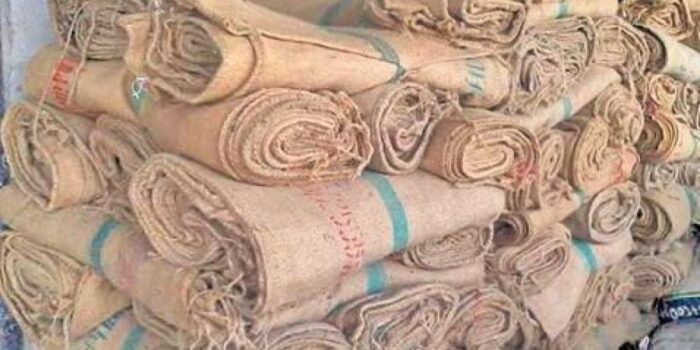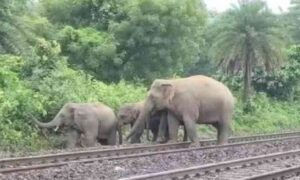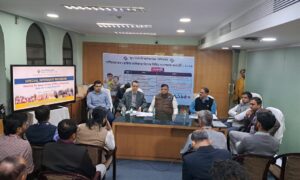
Image : Representational Purpose Only
In the long standing ” identity politics” of the north east demanding imposition of newer restrictions on movement of migrants to the region as if these instruments such as the Inner Line Permit system could stop such movement of people, the role of the “push” factor generated by science and technology driven ” market led development model” is conveniently ignored even today. This inhibits even a serious study of” the problem of migrants” let alone its resolution. This becomes apparent when one looks at the spread of cultivation of jute in Assam and Tripura.
No doubt jute is not a favoured crop as it is called” Mora Pat” in Assamese ( it is just Paat in Bengali) meaning the fibre of a dead plant that resembles Silk as paat means silk; and therefore jute is possibly the only plant species associated with death ! This might be due to “retting”, that is, the practice of putting first, the harvested plant into a slow running water for 10 to 30 days to allow for bacteria to dissolve the gummy materials holding the fibres together; and thereafter the non fibrous material of jute is scrapped off in a process called “stripping” and the fibres are separated by beating the stem with a paddle. The separated fibres are then washed, dried, graded and sent off to jute mills. The dried jute stick is excellent fuel ;and since Jute is a 120 days crop and grown only in lands endowed with high annual rainfall of at least 1000 mm requires alluvial soil, high humidity and temperature of 24-38 ° C and harvested in the monsoon months of July-August a rice crop could be grown thereafter. Not only this, as jute fields need standing water , the farmers release fish seeds and fingerlings in the same to get a good catch of fish too!
And as Jute also does not require fertilizer or pesticides it is a cost effective ,versatile, labor intensive crop which enables even small farmers to grow a food and a cash crop in the same land that also provides fish and fuel but critically demands that the farmers must be water friendly.
It is interesting to note that though jute was introduced in Assam well over a century ago, the indigenous people of Assam never took to its cultivation . Indeed your correspondent didn’t recall any ” indigenous” jute farmer of some standing during his long stints in the Agriculture department of Assam. This might be due to several factors such as the origin of some ethnic groups in the South East Asia hills which made them ” water unfriendly” and hence avoid jute farming which as clarified to me ” only water borne people like the” Immigrant Muslims” ( from Eastern Bengal) could grow jute!
The story of jute in north east as in Bengal is fascinating. Though there is historical evidence of use of jute fibres in ancient and Medieval India and in Egypt and riverine regions of Africa, China , Vietnam and even in Brazil , the economic potential of this versatile fibre plant was first realised only in 1830’s in Scotland when spinners at Dundee learned how to spin jute yarns by “modifying the power driven flax machinery”. These” looms” facilitated growth of jute factories in Dundee and massive increase in demand for jute which only large scale commercial cultivation of jute in India could meet. The colonial government thereupon launched experimental cultivation of jute along the east and west coast where agro climatic conditions were favourable. The results showed that delta region of Eastern Bengal and especially Mymensingh , Rangpur, Pabna and Bogra- now in Bangladesh were the most ideal for jute strains the scientists released after testing the same brought from different parts of the world including Brazil and produced the highest crop yield at the lowest cost. This induced the Scottish jute mill owners to set up factories in Bengal which began at Rishra near Calcutta in 1855 and by 1910 there were 38 Companies exporting about a Billion yards of jute cloth and 450 million bags when the industry felt the need for expanding jute cultivation in areas close to the factories along the river Hoogli in West Bengal to meet the rising international demand of products of jute- the golden fibre of Bengal that heralded the” first Green Revolution” in India. West and lower Assam Districts having similar agro climatic conditions were therefore the most obvious choice.
The task wasn’t easy though Jute had been grown in some parts of Goalpara for domestic use and some zamindars did attract Jute farmers- mostly from Mymensingh District as the local farmers were not willing to move to the flood prone lowlands or riverine Islands-” Chars” regardless of incentives the Zamindars might have offered. It may be noted that the erstwhile Goalpara, Sylhet and Cachar Districts of Bengal were ” transferred” to Assam when it was carved out of Bengal in 1874 and made a Chief Commissioner’s province mainly to promote Tea,Coal mining,oil exploration and therefore Jute was well within the overall colonial scheme of building an extractive economy. Thus in 1898 F. J. Monahan, Assistant Director Land Records, Assam suggested induction of East Bengali farmers to reclaim lands- a view endorsed by Henry Cotton , the Chief Commissioner of Assam , the strong Calcutta based British Jute industry lobby and the Bengal Chamber of Commerce. Thus opening up of the low-lying parts of Goalpara,Kamrup Nowgong and Darrang Districts as then constitued to jute farmers of neighbouring districts of Bengal was the outcome of the state policy to promote the colonial mode of production rather than organised move by hordes of migrants. Infact, implementation of”1928 Land colonisation scheme ” of the Government of Assam covering the Districts mentioned above , extension of Railway system to link the potential jute areas to Calcutta were measures taken to induce East Bengal farmers to move to Assam much like the way the Tamil labor moved to then Malay Peninsula to start Rubber plantations and mining of Tin and the Chinese followed to run the trade and business in the same century and for the same reason as in Assam – lack of local labor and skills.
If one looks at this narrative objectively, like Tea , introduction of jute is a similar success story of scientific introduction of a new crop, farming techniques and processing that put Assam in the third rank among the Jute growing states – only after Bengal and Bihar producing 1.6 million bales from about 70000 hectares which is enough to sustain 15 jute Mills of standard size though currently there are just two- one a co-op jute Mill at Silghat in Nagaon district while the other is in the private sector. There is thus a huge untapped potential to produce value added diversified jute products apart from gunnybags and Hessian such as carpets, rugs, sand bags and geo textiles for erosion and flood control . The post CVD 19 Pandamic world is certain to make stronger moves towards reduction of carbon footprints in line with the 2016 Paris Climate Agreement there is bound to a huge shift to use of natural biodegradable and breathable fibres such as jute in place of synthetics which is already seen in the rising demand for jute products in the European Union countries.
Jute and the people who grow the crop and are associated with it are therefore assets and deserve institutional support especially in Research and development as only a third of the estimated potential of jute of the north east has been tapped as the present jute output of Meghalaya(87000 Bales), Tripura (11000bales) and Nagaland (40000 bales) could be increased by bringing more land under jute. Thus value added jute products might as well be a major export from the north east to the ASEAN countries under the Act East policy and even a game changer.
No doubt jute has changed the economic and demographic profiles of all jute growing Districts being the outcome of an inexorable process of expansion of the colonial mode of production in Assam which is, frankly irreversible. And more so when its huge potential in other north east states demands expansion of area under jute. . It is time now for the north east to reconcile demography with economic history and sustainable development as a step to establish the Region’s economic identity.
[the_ad id=’22722′]


















